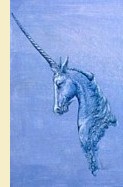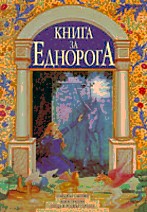


I MET LINDA AND ROGER GARLAND through first interviewing them for an anthology of their work for Paper Tiger Books. As had happened before, at the end of it we thought what fun it would be to do a book together from scratch. This was the first real chance that came along, thanks to our editor at the time, Pippa Rubinstein, who'd wanted to do a book about unicorns for ages. It turned out to be far more challenging than we could have dreamed, mostly for reasons that had nothing at all to do with the actual work, because without our knowing it our publishers were going out of business and trying to hide the fact. However, despite all the grief and politics, when the first copies arrived it still felt well worth the struggle and it remains one of my very favourite books. Which is why the unicorn has given a name to this website, and why I have kind of adopted it as my personal totem. One problem with this book was that my sub-editor carefully removed all my little jokes from the text so it emerged much more deadly serious than intended. But that didn't matter much as it happens, what mattered more was that I lost the BIBLIOGRAPHY that was meant to go at the end, including mention of one of my most helpful sources, Odell Shephard's Lore of the Unicorn. By way of revenge I helped have it republished by Senate Books in cheap paperback form. I was supposed to get to write an Introduction to it as part of the deal, but somehow that got lost in the rush. 
AN INTERESTING FACET OF UNICORNS is that people carried on believing in them long after they realised that dragons, gryphons and a host of other fabulous creaures only existed in their dreams. They believed in unicorns well into the 18th century and proved it by paying large sums to their local apothecaries for what they believed was genuine powdered unicorn horn, prescribed for a host of ailments including epilepsy. Meanwhile, for the sceptics many cathedrals across Europe had whole 'true' unicorn horns on public display. Water in which it had been dipped was given away as free medicine to the poor, because of the unicorn horn's fabled talent for dispelling poison. Such complete horns could fetch fabulous prices and in England one belonging to Elizabeth I, the Horn of Windsor, was valued at £10,000, several hundred million by today's prices, and the overall value of a complete town at that time. 

These horns were actually narwhal tusks and for centuries the kings of Denmark grew rich by guarding the secret of their true origins in the seas off Greenland and controlling the trade. Almost as a tease, they had made for themselves a throne of unicorn horn and gold that can be seen today at Castle Rosenborg, Copenhagen, and it made them the envy of all the other rulers in Europe. The bottom dropped out of this market in the 17th century when the truth became known, thanks to growing trade between Greenland and North America. In Frankfurt the apothecaries' price fell from 128 florins an ounce to just 8 between 1612 and 1669; and a complete horn belonging to Charles I of Britain fell in value from £8,000 in 1630 to just £600 in 1650. From those dark days of unpopularity the price of unicorn horns seems on the rise again, though for completely different reasons. In 1994 when I began writing this book one was auctioned at Christie's in London for nearly half a million pounds. As reported in the London Times, the seller had picked it up for a few pounds in the 1950s as part of a job lot of walking sticks being disposed of by Hereford Cathedral. 
ANOTHER INTERESTING FACT ABOUT UNICORNS is that they are not totally impossible creatures, as most people assume. Of course a horse with a narwhal-type horn would have to be a supernatural beast, but most heraldic and other antique depictions of unicorns agree that it has a cloven hoof, a silky beard and other goat-like features. Many early bestiaries even show and describe the unicorn as being a small, goat-like creature and one-horned goats, while rare, do actually occur from time to time in nature. 
In the book we have a section about a famous experiment by Dr Dove of Maine in the 1930s. Arguing that unicorn animals are not totally impossible, he proved his case by creating a unicorn bull, fusing its horn buds surgically together shortly after birth and planting them in the middle of its skull. What resulted was a single horn projecting straight from its forehead. This apparently gave the bull such confidence when it matured that it was remarkably docile in behaviour, seeming to have acquired some of the mythical unicorn's traits. You can read the piece by clicking on the picture right. 
HOWEVER, MOST OF THE BOOK is not about flesh and blood unicorns at all, but those from myth and legend - the magical creatures able to slip between this world and others where dragons still scorch the earth with their breath, and magic still prevails. Click on the thumbnails below for some stories we included.
I SUSPECT THAT FEW PEOPLE, especially unicorn enthusiasts, readily associate unicorns with beer. Some might even think they are opposed concepts but I've come across a couple of instances so far. Most famous is Kirin Beer of Japan, which has quite a wide international reputation; though I'm told by a friend there that even in Japan few people realize that the creature on the label is a Japanese unicorn. If you mention unicorns, most Japanese immediately think instead of the Western image. The Kirin is first cousin to the Chinese Chi-lin (or Qi lin in modern spelling), for more on which click on the scene of the Chinese Creation higher up the page. Then there is Mythos Beer in Greece which also carries a unicorn on its label. The brewery is quite a modern one so we're not talking about any ancient connection and it's interesting to speculate on the thinking behind the adoption of the symbol. And maybe that's not so hard because when you think about it, a few glasses of beer tend to lift the spirits and banish cares to a comfortable distance, which is much the same effect as the concept of unicorns, even knowing they are mythical creatures.
See more of Linda and Roger's pictures at the Lakeside Gallery |








